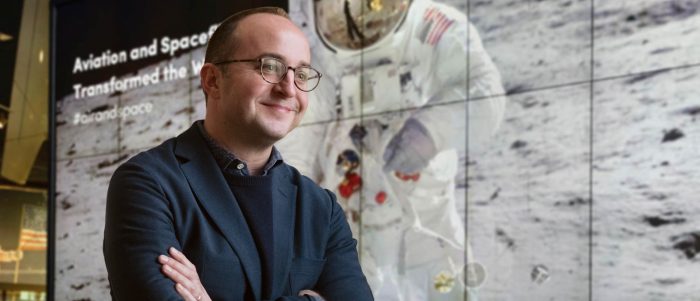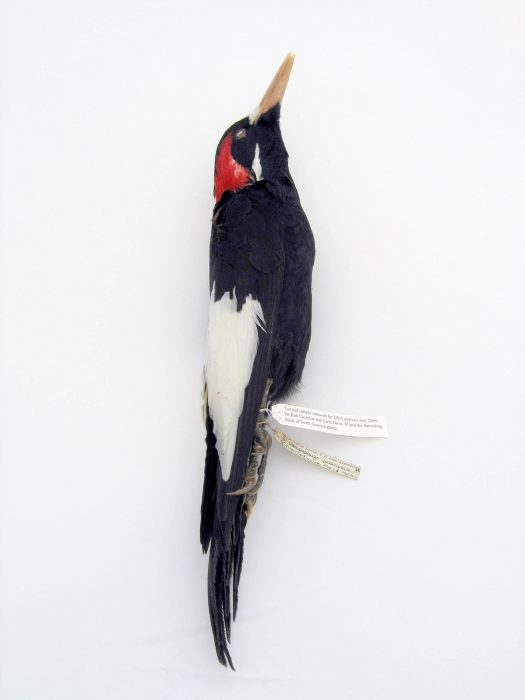A few of my favorite things: Darren Milligan
Smithsonian staff work countless hours in the halls of our museums and research centers, in the field, at the Zoo, in our gardens and facilities. We are privileged to spend time with some of the nation’s most cherished treasures as we go about our duties. Sometimes, these unique experiences find a special place in our own personal stories. Amy Kehs introduces Darren Milligan and a
fewlot of his favorite things.

Darren Milligan, senior digital strategist, Smithsonian Center for Learning and Digital Access (Photo courtesy Darren Milligan)
I’ve been writing the “My Favorite Things” series for Torch for about a year and I continue to be inspired by my colleagues and privileged to see the Smithsonian collections through their eyes. When I found out I would be interviewing Darren Milligan, senior digital strategist in the Center for Learning and Digital Access, I had a bit of a “Favorites” fan girl moment. We may as well crown Darren the King of “Smithsonian Favorites” since his work on the Smithsonian’s Learning Lab lines up seamlessly with this Torch series. I also suspected that the master compiler of collections might have a hard time choosing just three favorites.
Darren Milligan comes by the “education” gene honestly. Both his father and grandfather taught U.S. history in his hometown of Edinboro, Penn.; his sister teaches modern languages at a school nearby. Darren’s mom was an early COBOL computer programmer—Darren has melded his parents’ careers perfectly.
Darren majored in biology and Spanish at Allegheny College in northwest Penn. In the late 1990s, he took his first job out of college at the Purple Martin Conservation Association, a nonprofit organization founded by his uncle, ornithologist James R. Hill III, which works to ensure the future of North America’s largest swallow species. As with many organizations at the time, PMCA looked to young employees like Darren to help them figure out this new World Wide Web thing. He was assigned the task of creating an expanded website for the small nonprofit. He designed a site that soon was educating and connecting purple martin enthusiasts following the birds’ migration along the east coast of the United States. Similar conservation organizations began to recognize the potential of the Web and see how online communication, mentoring and sharing could influence and improve research. This type of collaborative research and interaction relies on what we now call “citizen scientists,” but at the time, it was a new concept and an exciting new way to use the fledgling Internet.
Darren eventually made his way to the D.C. area, where his experience, along with his passion for nonprofits and education, led him to a position as webmaster for what is now known as the Smithsonian Center for Learning and Digital Access in 2003. At the time, the office (then the Smithsonian Center for Education and Museum Studies) was mailing their “Smithsonian in Your Classroom” publication to about 80,000 schools across the country. However, SCLDA had little information about the expensive program’s impact: Was the publication useful and practical? Was it reaching its intended audience? Before moving to a digital format, SCLDA conducted extensive research asking teachers to give guidance and feedback about what would be most useful to them. The result of this feedback was the Smithsonian Learning Lab, an online tool that brings the Smithsonian’s resources to the classroom. Teachers and other users can discover new material, create and save a collection based on their findings and share with their students and other teachers. Learning Lab is not designed only for teachers; it is a great resource for anyone who is curious about our collections. The Lab is easily searched and each discovery may lead to more connections with other resources in the collection.
“We really wanted to communicate with people that the Smithsonian isn’t just a destination,” says Darren. “Learning Lab is a useful tool for learning that can be accessed anywhere.”
As anticipated, Darren had a hard time choosing three things from his current collection of 377 favorite items from our collections, so I gave him some leeway.

Ivory-billed woodpecker collected by Vernon Bailey in 1902. Courtesy National Museum of Natural History
His first pick is the ivory-billed woodpecker. The largest of the woodpeckers north of Mexico, the ivory-billed woodpecker was ubiquitous in the old-growth forests of the southeast United States 200 years ago. However, severe habitat destruction caused major population decline in the 1800s and it was thought that only a handful of birds remained at the turn of the 20th century. By the end of the 20th century, many experts believed the woodpecker to be extinct. But, in 2005 there was a sighting in Arkansas. The sighting has been difficult to replicate but bird enthusiasts remain hopeful. In fact, Darren’s uncle was one of the scientists that went in search of the bird after the 2005 sighting. Darren was able to see the Smithsonian’s ivory-billed woodpecker specimens, which were collected in 1902 by Vernon Bailey, at the Natural History Museum. Calling his uncle, who at the time was knee deep in the swamps of Florida, to tell him that he was looking right at the rare bird, remains one of his favorite Smithsonian memories.

Josef Albers “Homage to the Square” was featured on a stamp in 1980. The original artwork is on display at the Hirshhorn, the stamp is in the collection of the National Postal Museum. (Image courtesy National Postal Museum)
Darren’s second choice is Josef Albers’ “Homage to the Square,” which is on display at the Hirshhorn Museum and Sculpture Garden. The first collection Darren created on Learning Lab began with this painting. Learning Lab not only lets its users examine individual artifacts but also see how the artifact or resource relates to different units of the Smithsonian. Learning Lab helped Darren discover a 1980 postage stamp at the National Postal Museum that includes an Albers painting as well as a quote from the artist, “Learning Never Ends.” Seeing this quote on the stamp sparked Darren’s curiosity so he did some research and discovered that Albers was an art professor who had emigrated to the United States when his school was closed down by the Nazis in 1933. Albers eventually ended up teaching at Yale. This connection, that Albers was a teacher like Darren’s father and grandfather, lent depth to his understanding and appreciation of the painting, which has become one of Darren’s Smithsonian favorites.

Floor plan of the Arts and Industries Building in 1925, showing exhibits on display at the United States National Museum. Via Smithsonian Institution Archives
Darren’s third selection is a map of the Arts and Industries Building. The A&I Building was constructed in 1881 as the U.S. National Museum, the first building created solely for the purpose of housing the Smithsonian’s collections. When Darren came to work at the Smithsonian, his office was on the first floor in the northeast corner of the A&I building, creating one of those “only at the Smithsonian” connections: the employee who would help create the first digital collections worked in the building that housed the museum’s original collections so many years ago. One day, a colleague said, “Hey, did you know this used to be Michael Collins office?” Michael Collins, Apollo 11 astronaut and first director of the National Air and Space Museum had used that same space as his office until moving into the newly constructed NASM in 1976. Darren loves the architecture of the Arts and Industries building and learning this connection to the past really meant a lot to him.
“The Learning Lab is about bringing Smithsonian resources into people’s lives,” says Darren, “and it is also about the connections between the objects.” The Smithsonian has, at last count, 2.4 million resources available via the Lab and that number goes up every day. Darren and many colleagues across the Institution work diligently to make those resources accessible to everyone. They are the spokes in the wheel of the Smithsonian’s mission “for the increase and diffusion of knowledge” that James Smithson asked for 171 years ago. Darren’s ability to see connections between the artifacts, people and buildings gives him insight into how to help the Learning Lab education and inspire.
We knew Darren could never limit himself to just three favorites. Check out his collections on Learning Lab:
What are you waiting for? Start your own collections today!
Posted: 29 January 2018
- Categories:



